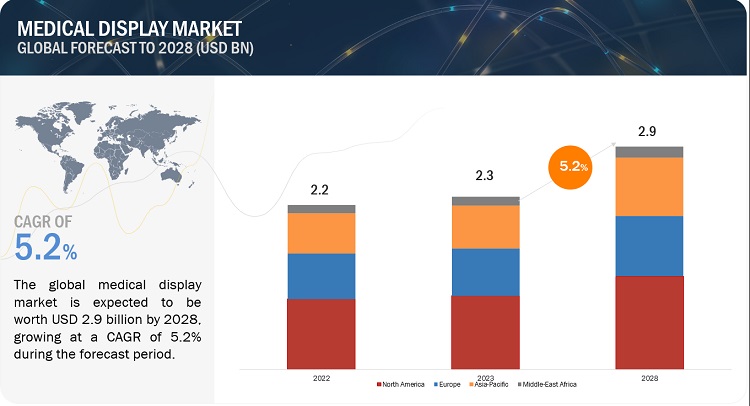In the realm of modern healthcare, the importance of advanced technology cannot be overstated. Medical displays, in particular, play a crucial role in diagnostic imaging, surgical procedures, and patient monitoring. These displays have evolved significantly over the years, driven by technological advancements aimed at improving image quality, diagnostic accuracy, and overall efficiency in healthcare settings. This article explores the medical display market, focusing on the key technologies: LED-backlit LCD displays, CCFL-backlit LCD displays, and OLED displays.
The global medical display market in terms of revenue was estimated to be worth $2.3 billion in 2023 and is poised to reach $2.9 billion by 2028, growing at a CAGR of 5.2%
Medical Display Market by Technology (LED-Backlit LCD Displays, CCFL-Backlit LCD Displays, OLED Displays) – Global Forecast to 2028
Download a PDF Brochure: https://www.marketsandmarkets.com/pdfdownloadNew.asp?id=74058413
LED-Backlit LCD Displays: Efficiency and Versatility
LED-backlit LCD (Liquid Crystal Display) technology represents a significant advancement over traditional CCFL (Cold Cathode Fluorescent Lamp) backlighting. LEDs (Light Emitting Diodes) offer several advantages, including improved energy efficiency, longer lifespan, and enhanced brightness and contrast ratios. These displays are capable of producing high-definition images with greater clarity and detail, making them ideal for diagnostic imaging applications such as radiology, cardiology, and pathology.
One of the standout features of LED-backlit LCD displays is their ability to achieve higher levels of brightness while maintaining lower power consumption compared to CCFL-backlit counterparts. This attribute is particularly critical in medical environments where accurate visualization of subtle details can impact diagnostic decisions. Moreover, LED technology allows for thinner and lighter displays, which contributes to the overall ergonomic design of medical workstations and surgical suites.
In recent years, advancements in LED technology have led to the development of localized dimming capabilities, where specific areas of the display can adjust brightness independently. This feature enhances image uniformity and contrast, further improving the diagnostic accuracy of medical displays.
CCFL-Backlit LCD Displays: Legacy Technology in Transition
CCFL-backlit LCD displays have been a staple in medical imaging for many years, providing reliable performance in various diagnostic applications. However, the shift towards LED technology has gradually reduced the prominence of CCFL displays due to several inherent limitations. CCFLs consume more power and have a shorter lifespan compared to LEDs. They also exhibit inferior color reproduction and contrast ratios, which can impact the accuracy of medical image interpretation.
Despite these drawbacks, CCFL-backlit LCD displays continue to be used in certain medical devices and installations where cost considerations and specific regulatory requirements may influence technology adoption. However, ongoing advancements in LED technology and the emergence of OLED displays are increasingly overshadowing the role of CCFLs in the medical display market.
OLED Displays: Setting New Standards in Medical Imaging
Organic Light Emitting Diode (OLED) displays represent the pinnacle of display technology, offering unparalleled image quality and performance in medical applications. OLEDs emit light directly from individual organic pixels, allowing for true blacks, infinite contrast ratios, and wider color gamuts compared to LCD technologies. This results in images that are exceptionally crisp, vibrant, and lifelike, which is critical for accurate diagnosis and surgical precision.
OLED displays are also characterized by their ultra-thin form factor, flexibility, and rapid response times, making them ideal for applications such as endoscopy, surgical navigation, and wearable medical devices. Their ability to render high-resolution images with minimal motion blur ensures that healthcare professionals can visualize intricate details in real-time, enhancing procedural outcomes and patient safety.
Despite these advantages, OLED technology faces challenges such as higher manufacturing costs and concerns over long-term reliability, particularly in environments prone to image retention (burn-in). However, ongoing research and development efforts are focused on overcoming these challenges to broaden the adoption of OLED displays across various medical specialties.
Market Dynamics and Future Outlook
The medical display market is dynamic and highly competitive, driven by continuous innovation and evolving healthcare needs. LED-backlit LCD displays dominate the market due to their balance of performance, cost-effectiveness, and widespread adoption. However, OLED displays are rapidly gaining traction, particularly in premium applications where superior image quality is paramount.
Looking ahead, the medical display market is poised for further growth with advancements in display resolution, color accuracy, and integration of artificial intelligence (AI) for image enhancement and analysis. Emerging technologies such as microLEDs and quantum dots hold promise for future display innovations, offering even higher levels of brightness, energy efficiency, and color fidelity.
In conclusion, the evolution of medical displays by technology—from traditional CCFL-backlit LCDs to advanced LED-backlit LCDs and cutting-edge OLED displays—reflects a continuous quest for improved diagnostic capabilities and patient care outcomes. As technology continues to evolve, healthcare professionals can expect increasingly sophisticated displays that enhance their ability to deliver precise diagnoses and treatments in a rapidly evolving healthcare landscape.

Leave a comment